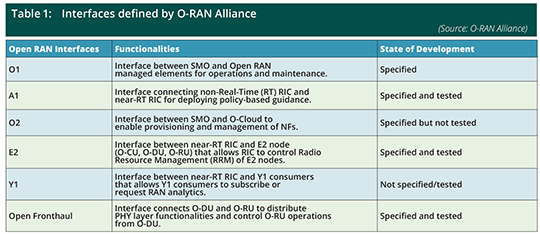What's Different in Open RAN on Top of 3GPP and What Needs to Be Standardized?
|
NEWS
|
The architectural complexity of cellular networks is increasing with the introduction of heterogeneous technologies. New developments will leverage a combination of technologies, including Artificial Intelligence (AI), Machine Learning (ML), Massive Multiple Input, Multiple Output (mMIMO), Millimeter Wave (mmWave), sub-Terahertz (THz) communications, and network slicing to manage and optimize the RAN. The existing RAN components are monolithic units, implementing each layer of the protocol stack that results in limited reconfiguration of the RAN, and limited coordination between network nodes that prevents automation and intelligence for RAN control and optimization.
In 2018, the O-RAN Alliance started the goal of implementing the principles of open interfaces, virtualization, and interoperability on top of 3GPP Long Term Evolution (LTE) and New Radio (NR) RANs. In particular, all three principles apply to the extension of the 3GPP NR 7.2 split for the Base Stations (BSs) that disaggregates BS functionalities into a Central Unit (CU), Distributed Unit (DU), and Radio Unit (RU) (using the following terminology: O-CU, O-DU and O-RU in Open RAN). For the sake of simplicity and cost efficiency of RU, the O-RAN Alliance has selected a specific PHY layer split 7.2x configuration out of 8 Functional Splits (FSs) defined by 3GPP. Moreover, a 7.2x split provides a fair trade-off between simplicity of interface and the RU design, fewer parameters to configure as compared to higher layer splits, and last but not least, the requirement of lower data rates for Fronthaul (FH) transport. On top of that, Open RAN connects such network functions to two Intelligent RAN Interface Controllers (RICs) via open interfaces to enable intelligence and automation within the RAN. However, all these architectural advancements that connect the disaggregated components of the RAN through open interfaces, such as O1, O2, A1, E2, Y1, and Open FH are being specified by the O-RAN Alliance that requires liaising with SDOs for the successful and complete commercial deployed of Open RAN solutions. Table 1 summarizes all Open RAN interfaces, along with their functionalities, and current state of development.

State of Open RAN Standardization Development:
|
IMPACT
|
The O-RAN Alliance consortium, which consists of vendors, operators, research institutions, and organizations, is busy transforming the RAN ecosystem toward an open, intelligent, virtualized, and fully interoperable RAN. Significant developments have been made to define and standardize Open RAN open interfaces and architecture, but the overall standardization will still need some time to complete. To date, the O-RAN Alliance is working on four major areas:
- Specifications and standardization, focused on expanding RAN standards from SDOs, e.g., ETSI, 3GPP, and ITU, to add intelligence and openness to the RAN.
- Software development, focused on developing open-source software for Open RAN networks functions.
- Certification and Badging Program aimed at constituting a mechanism for ensuring confidence in Open RAN solutions. Certifications and badges are issued by Open Testing and Integration Centers (OTIC).
- Testing and integration to provide guidance for testing and integration of Open RAN-compliant solutions.
The specification task of the O-RAN Alliance is subdivided into 11 different Working Groups (WGs), with each WG dedicated to a specific part of Open RAN architecture. Moreover, the O-RAN Alliance also includes four Focus Groups (FGs) that overarch the technical WGs, including, 1) the Open-Source Focus Group (OSFG) that deals with issues related to open-source Open RAN software; 2) the Standard Development Focus Group (SDFG) that deals with standardization strategies of the O-RAN Alliance and its main interfaces to other relevant SDOs; 3) the Testing and Integration Focus Group (TIFG) that defines the O-RAN Alliance’s complete approach toward testing and integration, creating End-to-End (E2E) test and integration specifications, and profiles to facilitate Open RAN production and commercialization; and 4) the Next Generation Research Group (nGRG) that focuses on research related to open and intelligent RAN principles toward 6G and future network standards.
As a way forward, the O-RAN Alliance is extending its collaboration with several organizations. In March 2023, the O-RAN Alliance signed a Memorandum of Understanding (MoU) with the OpenAirInterface (OAI) Alliance to collaborate on open RAN issues, open-source software development, and future networks. In January 2023, the O-RAN Alliance signed an MoU with ATIS that creates an opportunity for ATIS adopting Open RAN specifications and advancing research toward intelligent, open, and global standards-compliant RAN. During Mobile World Congress (MWC 2023), 58 O-RAN Alliance member organizations presented 65 demonstrations of their Open RAN solutions, including Intelligent RAN and Open RAN demonstrations. In September 2022, ETSI adopted the first Open RAN specification as “ETSI TS 103 859: O-RAN Fronthaul Control User and Synchronization Plane Specification v7.02.” The specification focuses on defining the Open RAN Open Fronthaul interface linking the O-DU and O-RU for the lower layer functional splits. The O-RAN Alliance is planning to submit more specifications to the ETSI Publicly Available Specifications (PAS) process to standardize and recognize additional components of Open RAN architecture as ETSI specifications. In July 2022, the O-RAN Alliance had published 52 specifications since March 2022, including 12 new titles for uses cases for mMIMO and the R1 interface, E2 interface testing, O2dms interface, Acceleration Abstraction Layer, outdoor macro cell Hardware (HW) and security. Moreover, the sixth release of open software was released by the Open RAN software community and the first certificate was awarded by Asian OTICs. Apart from specification development, there is still a need for E2E integration and interoperability testing of Open RAN interfaces for a complete standardized solution.
The Future of Open RAN: Standards of Open Source?
|
RECOMMENDATIONS
|
E2E integration and interoperability are two pillars of Open RAN, both of which are necessary to deploy Open RAN in both greenfield and brownfield networks, and to become a viable, cost-effective, and lucrative alternative to large vendor equipment. The O-RAN Alliance has become a domain of significant work, but also an environment where multiple parties now codevelop with creative differences. This may be one of the reasons that the work of the O-RAN Alliance has not accelerated and all functional interfaces are not yet fully specified. The fact that these interfaces are not yet frozen has caused some criticism in the industry and some operators have proceeded to deploy their own proprietary version of the O-RAN Alliance stack, which should be upgradable to the formal specification once completed. The question is how should the O-RAN Alliance proceed. Should it submit its specifications to other SDOs, perhaps 3GPP and then national SDOs, or should it remain open and let the market decide?
One could argue that enforcing O-RAN Alliance specifications as standards could lead to the very same proprietary extensions and vendor lock-in the market has experienced so far. On the other hand, remaining completely open, without clear deployment guidance, could perhaps delay specifications even further, turning away potential deployment opportunities. Thus, it is imperative that Open RAN vendors, leading operators, and research institutions establish integration labs that expose critical challenges when integrating different vendor equipment, addressing these before large deployments commence.


